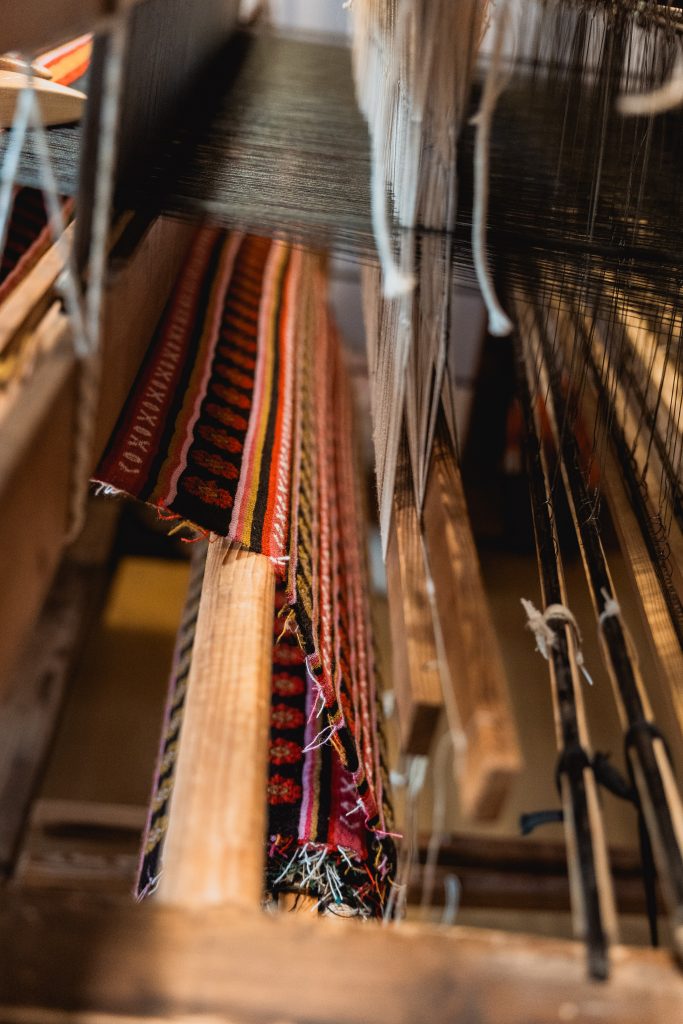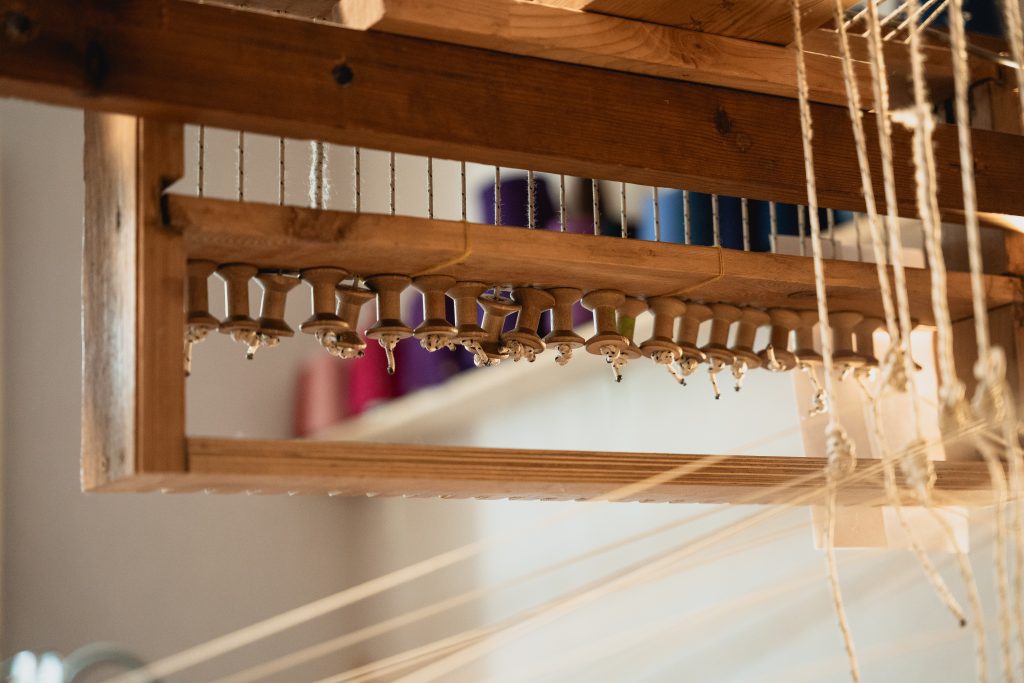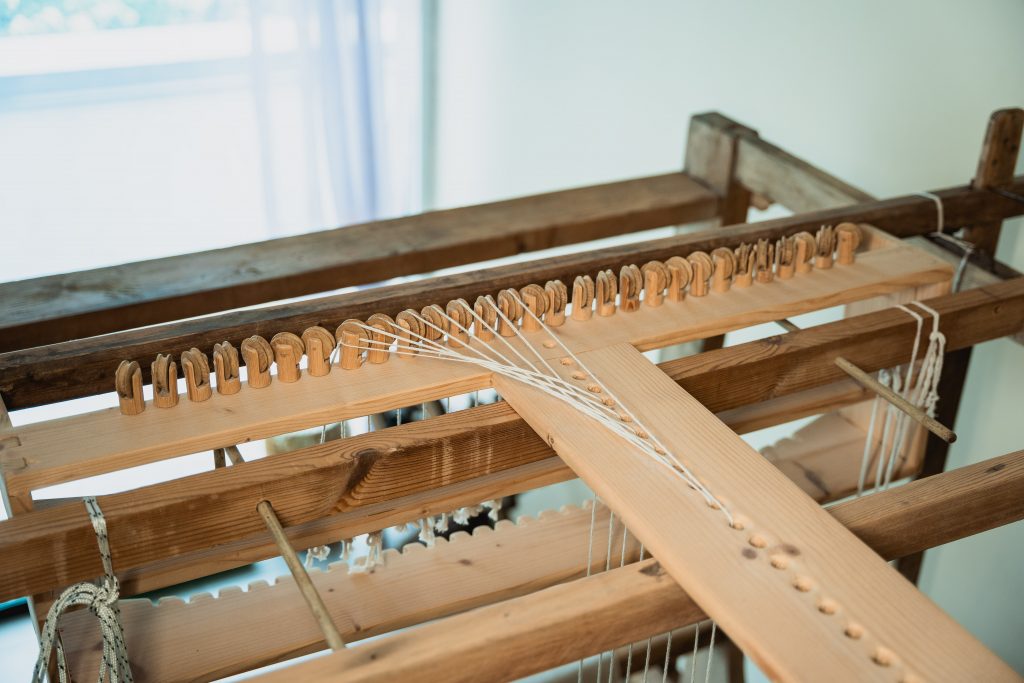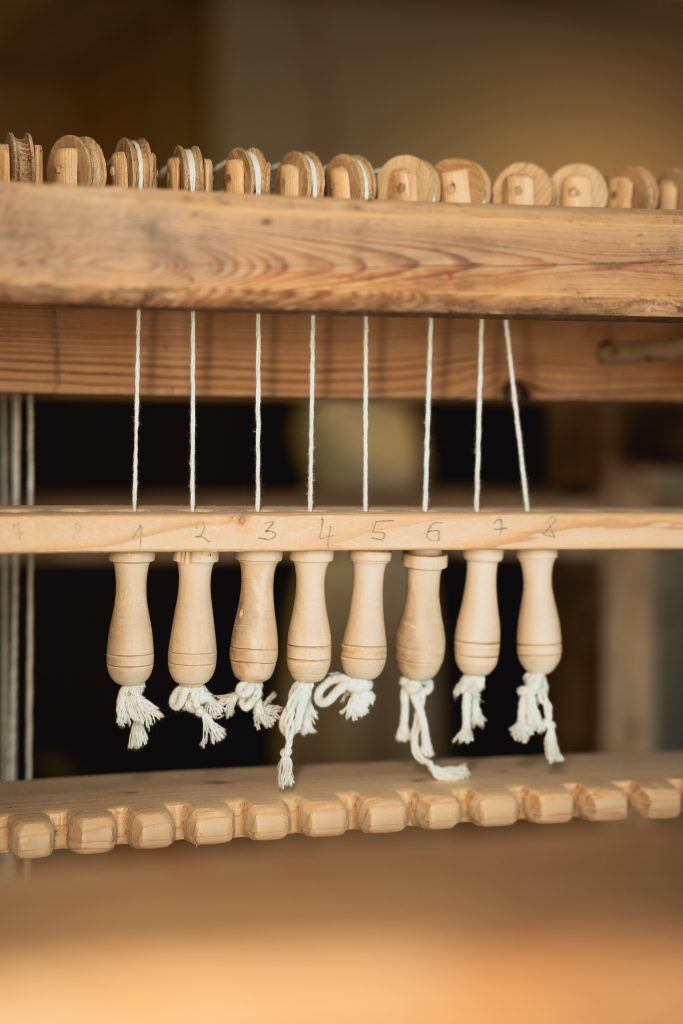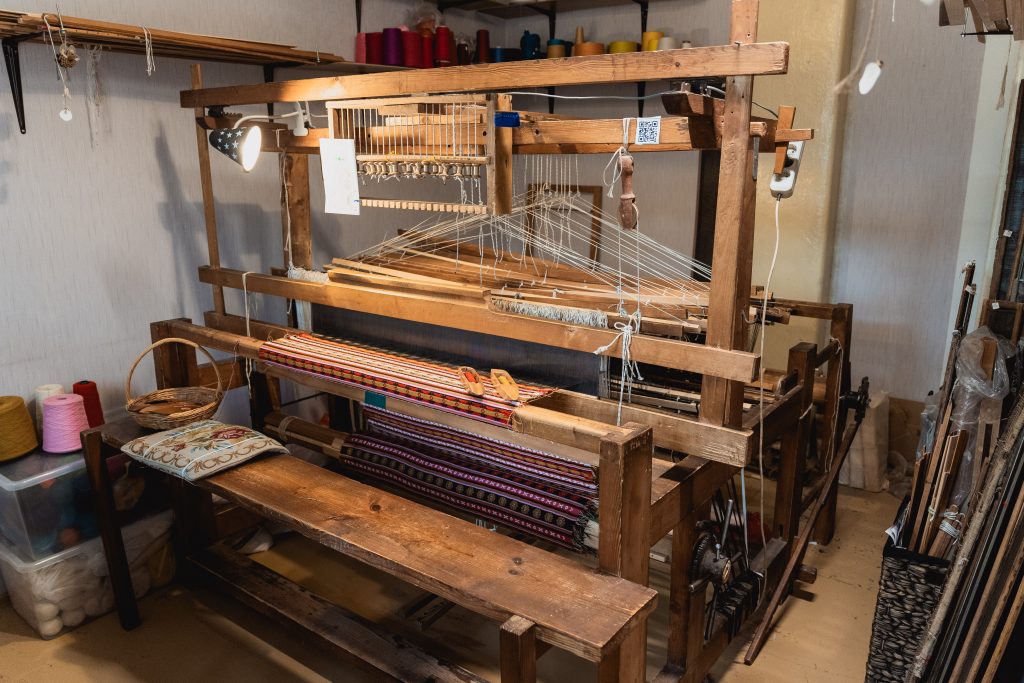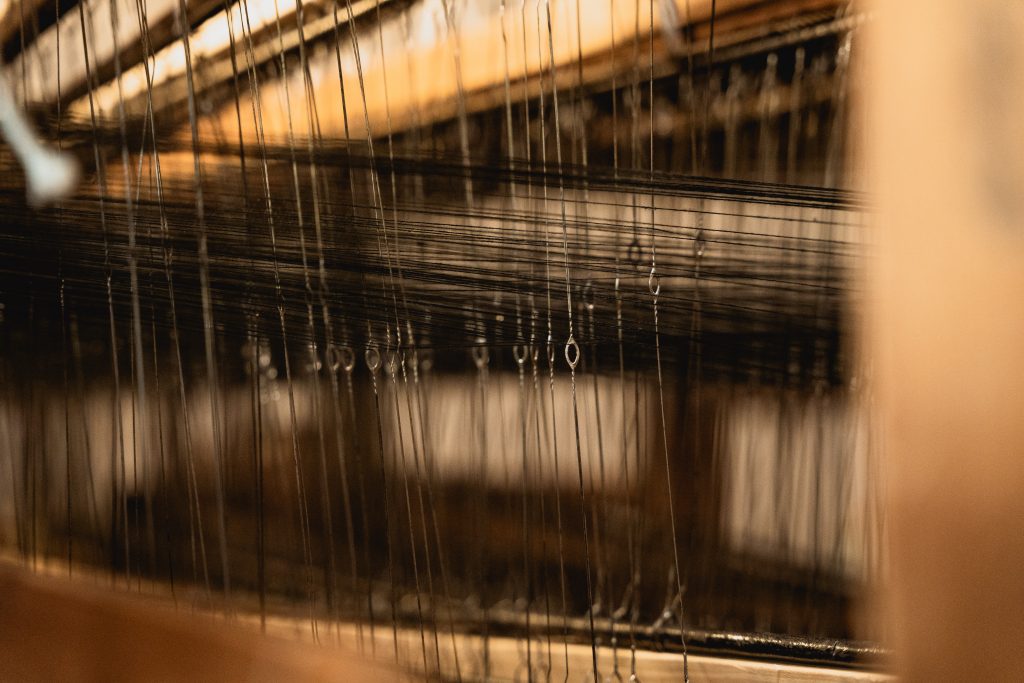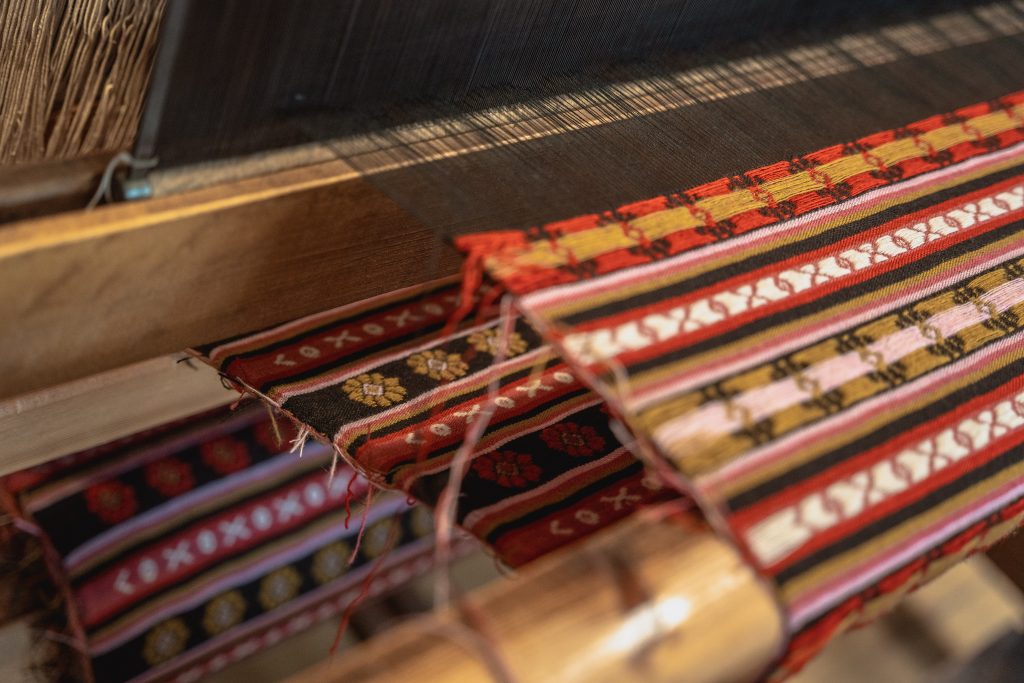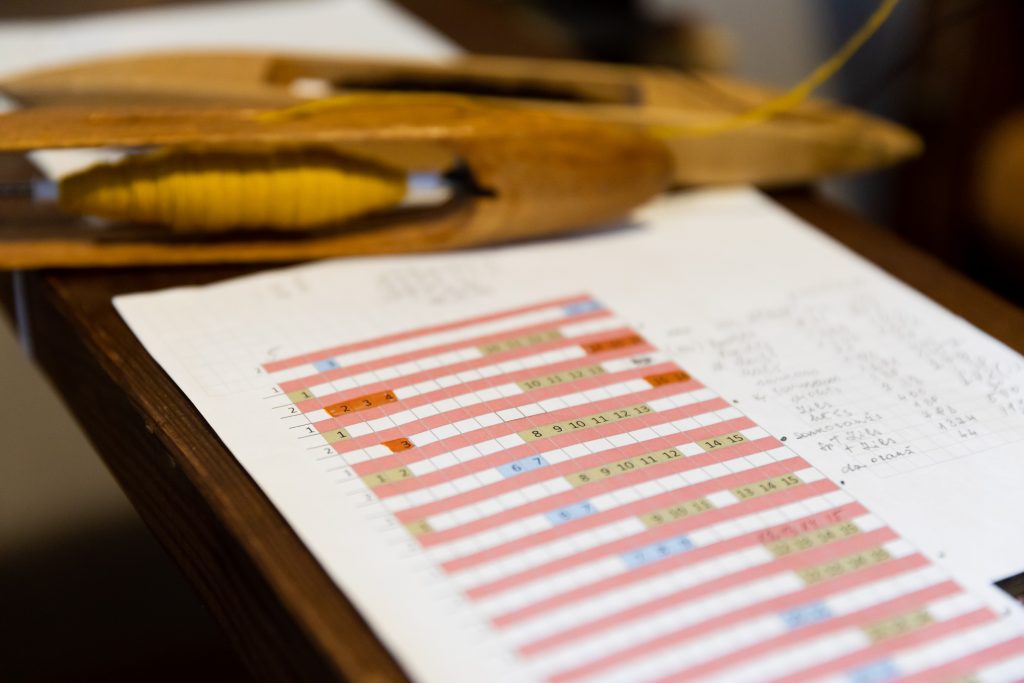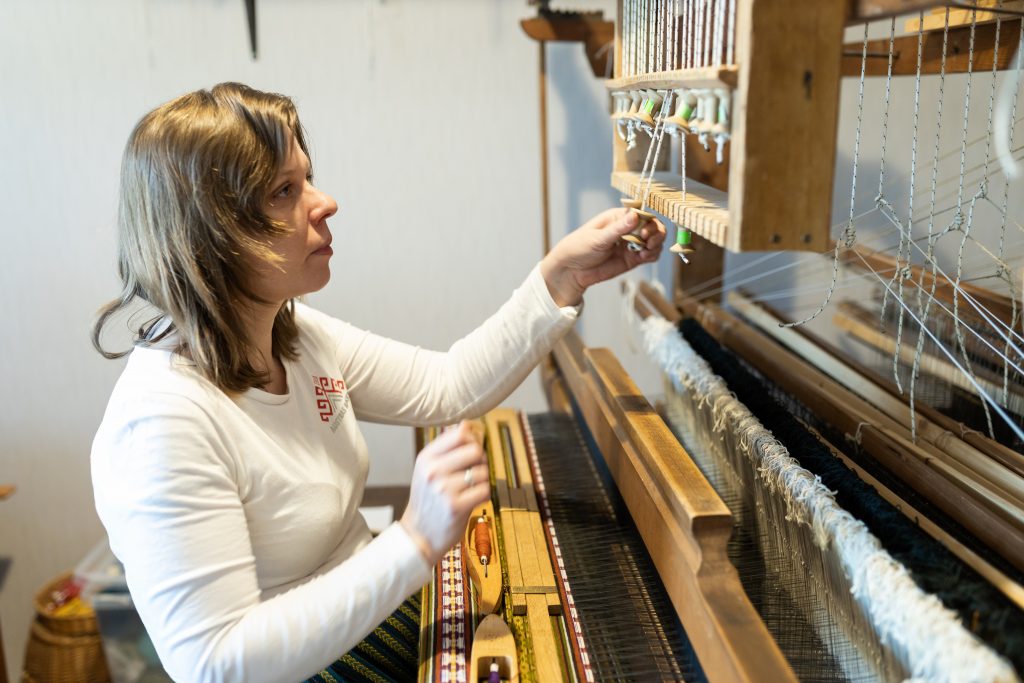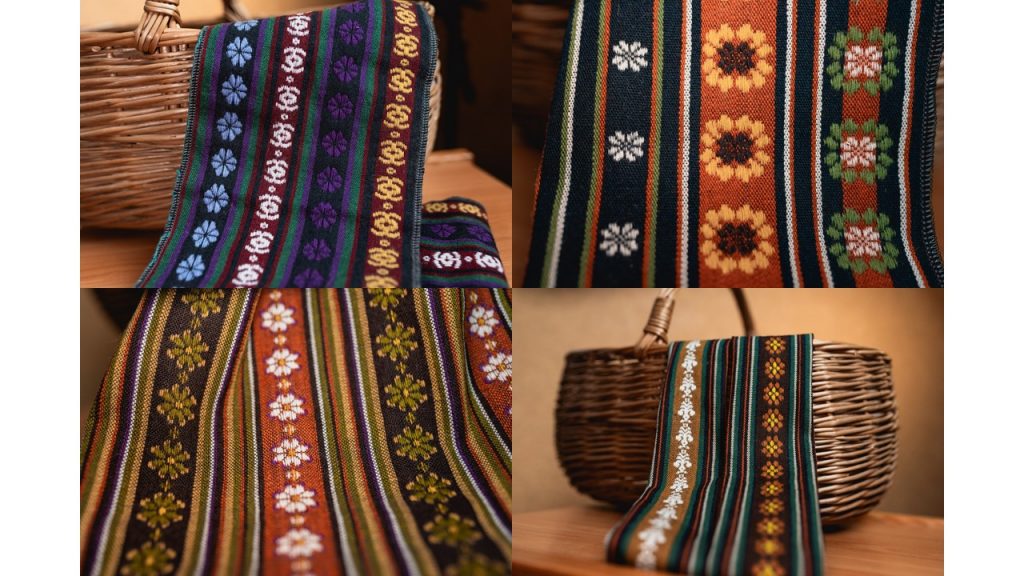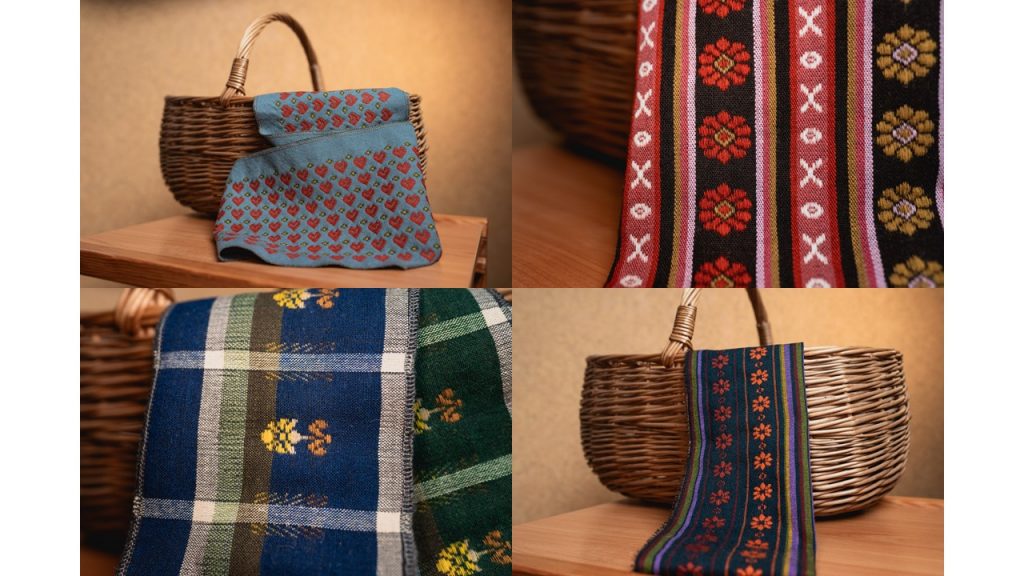Author:
Aija Mallkalns, Edgars Mallkalns
Traditional craft skills
Title
Weaving of Patterned Zemgale Skirts Using Drawlooms (2021)
Also known as “teat looms” in Latvian.
“Teat looms” is weaving jargon in Jelgava because the action of pulling on handles to activate the shafts resembles the milking of cows.
Geography
Zemgale, but also in Rīga, Vidzeme, and a few other localities in Latvia.
There are two separate but interconnected communities that are concerned with this element. The first are the weavers of ethnographic cloth and the second are those who make use it, which includes dance groups, choirs, folklore groups, and individuals who wear traditional clothing. These two communities are united in their desire to make use of the patterned skirts of Zemgale. This is a thread that defines this community’s identify and desire to represent the region of Zemgale.
In preparation for this application, a survey of amateur national costume makers and folk art studios (“TLMS” in Latvian) was carried out across Latvia. 111 individual invitations were sent out by email. Invitations were also placed in two Facebook groups, “Gribu savu tautastērpu” [I want my own national costume] and “Virtuālā aušanas studija” [the Virtual Weaving Studio]. 43 respondents completed the survey. Another 45 TLMS leaders and staff were interviewed by telephone. The data obtained shows that twelve, the largest number of drawlooms is located in Vidzeme. There are also four in Rīga and Kurzeme and one in Latgale and Sēlija. However, not everyone makes use of this device. There are nine active users in Zemgale, four in Vidzeme, and three in Rīga and Kurzeme. Drawlooms are available to and used by 20 respondents, of whom 16 have trained other weavers and/or demonstrated looms and weaving skills on educational excursions.
The following respondents who utilise drawlooms have taught other weavers, organized weaving demonstrations and excursions:
– Aizputes Culture House TLMS “Kamolītis”.
– Auce District Culture House TLMS “Auce”.
– Ausma Spalviņa, Jelgava.
– Jana Eveliņa, Jelgava.
– Jaunpils District Culture House Applied Arts Group “Dzīpars,” Jaunpils Craft House.
– Sarkaņu Craft School, Madona District.
– SIA “Austras raksti”, Jelgava.
– SIA “Mailīšu Fabrika”, Ērgļi.
– TLMS “Auseklītis”, Carnikava.
– TLMS “Bēne”.
– TLMS “Durbe”, Tukums.
– TLMS “Rīdze”, Rīga.
– TLMS “Rota”, Rīga.
– TLMS “Saiva”, Ogre.
– TLMS “Saulgrieži”, Krustpils.
– Vecpiebalgas Weavers Group (no longer in use).
Other respondents who use drawlooms are:
– Anta Strauta, Jelgava.
– “RadDoma” Association, Jelgava.
– Pastendes Culture House Folkr Art Collective “Kurši”.
– TLMS “Liepava”, Liepāja.
Another twelve respondents indicated that they have access to drawlooms but for a variety of reaons do not make use of them (e.g. loss of specific skills due to generational change; absence of advice from experienced weavers):
– Baiba Bite, Jēkabpils.
– “9Arodi” Association, Limbaži.
– Burtnieki District Rencēnu Parish Culture House Weaving Studio “Rencēni”.
– Ira Paegle, Lielvārde.
– Jūrmala Cultural Centre Artists House Weaving Studio “Bulduru audējas”.
– TLMS “Krimulda”.
– Rīga Culture and Folk Art Centre “Ritums” TLMS “Draudzība”.
– Saldus Culture Centre TLMS “Saldus”.
– Siguldas Parish Culture House TLMS “Vīgrieze”.
– TLMS “Bauska”.
– TLMS “Ulbroka”.
– Vecpiebalga Weavers Group.
The data indicates that 22 respondents are interested in learning to weave and acquire a drawloom. The main reason for learning these skills is the desire to weave complex patterns and cloth for patterned Zemgale skirts.
Importance in Community Life
Drawlooms are crucial in the weaving of Zemgale patterned skirts. The name of the element was chosen to reflect this: “The Weaving of Patterned Zemgale Skirts Using Drawlooms.” Other types of complex and patterned fabrics such as blankets and tablecloths can also be woven with drawlooms, but this type of work is more characteristic of other regions. In Zemgale, the emphasis is on weaving patterned skirt fabrics.
The drawloom can be attached to either a countermarch or jack loom. It consists of a board and a frame that is added to the end. The board contains holes that correspond to the number of shafts that the weaver intends to weave with. The more shafts there are, the more complex are the patterns that can be woven. The other important difference lies in the length or depth of the back section which determines how many shafts can be placed on the loom. There are looms where the back section can be extended (see the Appendix on “Working with the Drawloom”).
Older weaving skills and traditions are gradually losing their meaning. These days patterned fabrics can be woven in factories as well as on computerized looms or Peteris Vilumsons looms, which cannot, though, fully be considered to be crafted by hand (except for maybe Viļumsons’ looms). If there is a desire to maintain older weaving traditions and skills and weave ethnographic fabrics with nineteenth-century-appropriate methods and techniques, then drawlooms must be considered the definitive and most practical way to weave authentic patterned Zemgale skirts.
It is important to the weaving community to which the applicant of this project belongs (SIA “Austras raksti”) as well as other professional weavers, folk art studios, and other weavers (see section “Communities Associated with the Element”and “Individuals Associated with the Element”) to safeguard the skills required to weave patterned fabrics using drawlooms because it is a specialized technique for the weaving of patterned ethnographic cloth.
If this weaving skill and tradition is not safeguarded, it will not be possible to weave the patterned skirts characteristic of Zemgale with the weaving technique appropriate to the locale and time period that was available to rural artisans.
The data obtained by this survey reflects the significance of this tool – one-quarter of all respondents expressed the desire to learn to weave using a draw loom.
Over the course of this project, LMS “Tīna” from Tīnuži have invited SIA “Austras raksti” to assist and consult on setting up a drawloom. The Studio is interested in acquiring a drawloom, setting it up, and learning to weave patterned fabrics.
The people connected with the use of drawlooms, safeguarding weaving skills, and transmitting these skills to others are weavers of ethnographic cloth who have access to drawlooms and the requisite skills to use them or at least the desire to acquire them. These are professional weavers – entrepreneurs, folk art studios, craft house members, hobby weavers, private persons and other weaving enthusiasts.
The best chances of safeguarding weaving skills and transmitting them lie with folk art studios and craft houses, whose leaders can train other members in weaving. The survey indicates that 15 of the 18 respondents who still use a drawloom are members of studios.
There is additional motivation to develop these skills for those professional weavers who would like to weave and make ethnographically accurate traditional clothing using the techniques and methods of their period of origin. It was the conclusion of this project that in times past drawlooms were a device employed by professional weavers.
Activities
Weaver Ilga Madre describes the drawloom:
“The drawloom is used to avoid the use of too many treadles when weaving complex weft-faced patterns. The drawloom replaces the pattern treadles.
The drawloom can be used with both jack and countermarch looms and consists of a frame with a board attached. The frame consists of two side boards and three horizontal boards.
All three boards have 16 to 24 holes drilled into them at intervals of 2.4 to 4 centimetres. The holes on the bottom board are notched on the front side and they are numbered.
16 to 24 holes and drilled into the top board at intervals of 3 to 4 centimetres and bobbins are attached so that draw cords slide more easily.” (Ilze Madre “Aušana”, Rīga, Avots, 1993).
A most detailed discussion of weaving with a drawloom and the experience of “Austras raksti” can be found below.
A more detailed discussion about weaving with a drawloom and the experience of the “Austras raksti” Studio can be found below.
More detailed descriptions and technical drawings can be found in Ilze Madre’s book “Aušana” (Rīga: Avots, 1993) and Anna Antena’s book “Aušana”(Rīga: Lauksaimniecības pārvaldes pirmizdevums, 1931; reprinted in 2017).
Inheritance and transmission
Research to date has not shown evidence of any particular modes of transmitting skills associated with the drawloom. We can assume that prior to the Soviet occupation weaving skills among were handed down from generation to generation as they were among other artisans through study with experienced masters, but since the early twentieth-century they were also learned in trade schools. The history and transmission of trade skills (including weaving) are discuss in great details in Aina Alsupe’s book “Audēji Vidzemē” [Weavers in Vidzeme] (Rīga: Zinātne, 1982).
Folk art studios have become important sites where traditions were safeguarded and nurtured and they continue to do so today. One prominent Folk Art Master, crafter, teacher, and author was Ilga Madre (1921–2002), who was until 2002 the director of the Ģ. Eliass Jelgava History and Art Museum’s Folk Art Studio “Atspole.” She wrote nine books about handicrafts, including “Aušana,” where she described the assembly and preparation of a drawloom.
The survey data indicates that ten respondents from studios have acquired the skills required to operate a drawloom through study. Another twelve have learned through self-study with the advice of experienced weavers (including relatives) through six difference institutions and three at the “Māksla,” an earlier manufacturing facility.
Respondents have named the following educational institutions where they have learned weaving skills: Rīga Applied Arts High School, Liepāja Applied Art High Schoo, and the Rēzekne Art School.
Aija Mālkalna, the author of this application, acquired her skills at the LLU Faculty of Food Technology specializing in Home Economics and honed those skills further at the Folk Art Studio “Dardedze” in Jelgava with Ingrīda Ozolniece, who led this studio for 50 years. However, Aija Mālkalna learned to use a draw loom through self-study and consultation with experienced masters.
We can identify the following three learning opportunities by systematizing the acquisition and transmision of weaving skills:
– Participation in Folk Art Studios.
– Reading the relevant literature.
– Training with experienced masters.
History
In the 1880s, as the German gentry thought about how to employ their peasants more intensively during the winter, they were looking for ways to implement more productive tools and techniques to increase their profits. To this end, weavers were sent to Finland and master weavers were invited to come to Latvia to teach Master Weaver Courses. These instructors taught their students to weave with the countermarch looms that were common in Scandinavia. A variety of decorative fabrics could be woven including twills, crepe, rosepath, and huck patterns. “Since these courses were taught by specialists trained in Finland and Sweden, people called these weavers Finnish weavers and the fabrics that were created through previously unknown techniques as Finnish cloth” (Finnish Weavers book 2019, 24)
The idea of weaving patterned fabrics in the nineteenth century comes from Europe where complex patterns were woven on Jacquard, Damask, and Dobby looms, but draw looms were used in Sweden and Finland. It was only in the 1880s under Scandinavian influence that countermarch looms with drawbridges were accepted by weavers in Latvia, who used them widely.
Information about patterns from the 1880s can be found in a variety of ethnographic studies.
Biruta Zunde (1925–1990), a graduate of the Latvian Home Economics Institute and author and editor of volume 3 of “Latviešu tautas māksla” [Latvian Folk Art] focussed on clothing, wrote that “Patterned and multi-coloured fabrics were made primarly by artisans. In older fabrics the patterns were created by picking but in the nineteenth century home-made drawlooms are known to have been used for weaving patterned cloth” without including a reference to specific time periods (Zune 1967, 15).
Ethnographer Mirdza Slava (1924–2001) opines, that skirts with patterns where patterns where manually picked were known to have existed early in the nineteenth century (Slava 1966, 49).
We should note that while Slava’s conclusion is based on a 1805 sketch (held by the Monument Board) of some patterned skirt fabric that had been sewn into the lining of a coat, it is difficult to be definitive about how precise this dating is. However, it is known that in the nineteenth century that worn-out clothing was refashioned into items such as children’s clothing or coat lining.
In her book “Audēji Vidzemē 19. gs. 2. pusē un 20. gs. sākumā” [Weavers in Vidzeme in the Second Half of the 19th and early 20th Century], ethnographer Aina Alsupe describes various types of Finnish weaves, which were woven using as many as 32 shafts. The author emphasizes that most of the fabrics were woven on farms while the most complex were woven at professional weavers shops (Alsupe 1982, 66, 94–97).
In her study “The Development of Clothing in Nineteenth-Century Zemgale,” Aija Jansone has assembled the extant nineteenth-century skirt fabrics from Zemgale that have been woven in the Finnish style (Jansone 2016, 94–104).
In 2019, the Latvian Open-Air Ethnographic Museum published a reprint of an 1880 weavers manuscript including Aija Jansone’s scientific commentary “A Consideration of the Development of Weaving in Latvia in 18th to 20th Century Latvia” where she explained the Finnish weaving courses’ prerequisites, content, and outcome. She also set out the development of the developent of the loom in Latvia (Jansone 2019, 7–51). The facsimile section of the books contains the weaving theory of the 1880s, weaving drafts, and 153 fabric swatches.
Just like in the late 19th century, today draw loooms are mostly used by professional artisans as well as a few weavers who weave for pleasure.
Late in the nineteenth century patterned skirt fabrics became very popular in Zemgale and elsewhere in Latvia (e.g. Rucava, Kuldīga), especially as part of a folk costume. In the beginning these were part of one’s best clothing that was worn for family celebrations and special events, then today they are mostly worn by amateur arts groups such as choirs, dance groups, and for performance by folklore groups. They are also worn by countless other individuals. Because of these groups to wear a variety of different stage clothing from a variety of religions, the area where Zemgale patterned cloth is used has expanded to all of Latvia. This pertains to both weavers and those who wear this clothing.
The relevance of drawlooms to the weaving of patterned fabric has not changed. During the period these skirts became popular weaving was basically done by professional rural artisans using drawlooms. Today too drawlooms are used by weavers who are entrepreneurs, members of folk art studios, and other expert weavers. Today there is also the option of using industrial and computerized looms, but if we would like to obtain the kind of patterned skirt fabric that matches the pattern, fabric structures, and technique of those created at the end of the nineteenth century on farms and in weaving workshops then drawlooms are the only way to achieve that goal.
Weavers today have developed thei own names for the patterns found in Zemgale skirt patterns. These include “the little flower in a flower pot,” “the little palm tree,” “the little daisy,” “the little crayfish,” “the little stars,” “little hearts,” “little rose,” and others.
We thank Aija Jansone for her assistance in the compiling the history of this element.
Masters
– Aija Krūmiņa, TLMS “Rota” director and weaver (Rīga).
– Aija Mālkalna, SIA “Austras raksti” director and weaver (Jelgava).
– Anita Rauda-Žukovska, SIA “Austras raksti” weaver (Jelgava).
– Anta Strauta, weaver (Jelgava).
– Ausma Spalviņa, Jelgava.
– Daira Drozdova, Sarkaņi Craft School Weaving Group Director, Weaver.
– Ilze Gailāne, TMLS “Bēne” director and weaver.
– Ilze Mailīte, SIA “Mailīšu fabrika” executive member and weaver (Ērgļi).
– Jana Eveliņa, TLMS “Dardedze” member (Jelgava).
– Māris Maniņš, TLMS “Rīdze” director and weaver (Rīga).
– Velga Pavlovska, Jaunpils Craft House director and weaver.
– Vineta Šulca, TLMS “Durbe” director and weaver (Tukums).
– Zane Ulmane, TLMS “Auseklītis” director and weaver (Carnikava).
Institutions and Organizations
In the course of preparing this application, the weavers and institutions who have experience in weaving with a drawloom were identified. These can be considered the institutions connected with this element who have the ability and desire to participate in the safeguarding of the skills of weaving with the drawloom. [TLMS is Folk Arts Studio in Latvian]
– Jaunpils Craft House
– Sarkaņi Craft School Weaving Group
– SIA “Austras raksti”, Jelgava
– SIA “Mailīšu Fabrika”, Ērgļi
– TLMS “Bēne”
– TLMS “Durbe”, Tukums
– TLMS “Liepava”, Liepāja
– TLMS “Rīdze”
– TLMS “Saulgrieži”, Krustpils
– TLMS Rota, Rīga
Strengthening the Tradition
SIA “Austras raksti” has had a drawloom since 2018. Weaving skills were acquired through self-study utilizing the available literature and by observation of the drawloom in action at the Jaunpils Craft House and in consultation with the Jaunpils Craft House director Velga Pavlovska.
SIA “Austras raksti” won third place with a Zemgale national costume from Bukaiši Parish where the white patterned summer skirt had woven with a drawloom.
Weaving with a drawloom was demonstrated during the Latvian National Cultural Centre’s “Meet Your Master” event when participants had the opportunity to take part in both warping a loom and learning weaving techniques. One of these participants was so inspired, she wove her own patterned Zemgale skirt.
The participation of folk art studios, individual artisans, and entrepreneurs in the “Meet Your Master” event with weaving masterclasses and teaching excursions for drawlooms and weaving basics is a positive development. In 2020, there were 37 activities related to weaving. The more people learn the basics of weaving, the greater the possibility that they will become interested in more complex weaving techniques including drawloom weaving.
Since the 2018/19 academic year, the “Austras raksti” activity programme “From Wool to National Costume” has been part of the “Latvian School Bag” project through which students are offered the opportunity to try weaving, hear exciting stories, and watch drawloom in use.
In the last few years, more than twelve different Zemgale skirt fabrics have been woven at the “Austras raksti” Studio (swatches can be found in the Gallery below). New skills have been acquired that permit the weaving of precise fabric and pattern reproductions that match either the original fabric sample or photograph or drawing. More than 200 students from schools in Jelgava and Dobele town and counties attended classes during the first school years. The knowledge and experience gained will make it possible to ensure the preservation and transfer of this tradition.
The “Austras raksti” Studio began developing the project to inscribe Drawloom weaving into the List of Intangible Cultural Heritage as part of the Zemgale Planning Region’s “Zemgale Cultural Programme 2021”.
The goal of the project is to develop a high-quality application to the Latvian National Cultural Centre to inscribe drawloom weaving into the National List of Intangible Cultural Heritage.
The submission and acceptance of this project would be an important step to the promotion of the intangible cultural heritage of Zemgale.
Matching funding has been provided by AS Latvijas valsts meži [Latvian State Forests] and Valsts kultūrkapitāla fonds [State Culture Capital Foundation].
Continuity/Development
In terms of research, SIA “Austras raksti” plans to:
• Identify and study lesser well known fabric samples found in museum collections, create weaving drafts for warping and pattern weaving.
• Seek out resources for the development of drawloom weaving in international publications.
In future years, SIA “Austras raksti” plans the following activities to support the safeguarding, development, and promotion of the element:
Educational activities:
• Weaving masterclasses and training in weaving.
• Continue to participate in projects “Meet Your Master” and the “Latvian School Bag” where weaving demonstrations and opportunities to weave will be offered.
The marketing plan includes:
• Organizing an exhibit of Zemgale patterned skirts in conjunctions with the institutions and persons involved in safeguarding the element.
In the course of her research at the Latvian National Museum, Aija Jansone found 86 different patterned skirt patterns (A. Jansone, “Apģērba attīstība Zemgalē 19.gadsimtā” [The Development of Clothing in Zemgale in the Nineteenth Century], LNKC, 2016). This wealth of patters means that there are still opportunities to singificantly increase the variety of skirt patterns available to dance groups, choirs, folklore groups, and others who would like national costumes.
The goal of holding weaving demonstrations and trainings is to promote the acquisition and transmission of weaving skills, the demonstration of an ancient craft, as well as increasing public understanding of the process of making a national costume and the labour that is involved.
The development of weaving technique and implementation of more opportunities will allow for opportunities to develop new types of cloth and so promote drawloom weaving.
Threats to the Tradition
There are threats to the safeguarding and transmission of drawloom weaving that are similar to those affecting other crafts that involve a high proportion of handwork.
Artisanal hand crafted work is still insufficiently valued because of the low purchasing power in Latvia and a lack of understanding of the investment, quantity, and true cost of the labour involved. The artisans themselves frequently price their work too low. As a result, the younger generation loses interest in safeguarding the handicraft tradition and there is a growing to use mechanized modes of fabrication that replaces the work of artisans and ancient skills to reduce costs. Still, as noted above, whenever possible, the technology appropriate to a specific time period should be used to create authentic national costume fabrics. For this reason, the drawloom it is best to weave patterned skirt fabrics from Zemgale on a draw loom.
The safeguarding of tradition is not facilitated by current practices of assembling national costumes for amateur groups where priority is given to lowering costs without regard for quality or ethnographic appropriateness.
If we are not able to motivate the younger generation of weavers to learn drawloom weaving skills, we will gradually loss this special traditional artisan skill.
Applicant
SIA “Austras raksti”, registration number 43603071566
Photo Gallery
Video Materials
Text Materials
Publications
Madre, I., 1993. “Aušana”. Riga: Avots.
Antens, A., 1931 and re-edition 2017 “Aušana”. Riga: First edition of Agricultural Administration 1931.
Jansone, A., 2016. Apģērba attīstība Zemgalē 19.gs. Riga: Latvian National Centre for Culture.
Jansone, A., 2019. Somu audēju grāmata. Ieskats aušanas mākas attīstībā Latvijā 18.-20. gadsimtā. Riga: Zinātne.
Zunde, B., 1967. Apģērbs. Grām.: Latviešu tautas māksla. XVIII gs. beigas – XIX gs., 3 volumes, editor M. Stepermanis. Riga: Liesma.
“Novadu tērpi. Zemgale", Latvian Agricultural Chamber Edition 1938 In Jelgava, the Palace of Viesturs.
Apine Hermane, A., 2020. "Aušanas tehnikas Latvijā". Riga: Zvaigzne ABC.
Alsupe, A., 1982. Audēji Vidzemē 19. gs. otrajā pusē un 20. gs. sākumā. Riga: Zinātne.
Slava, M., 1966. Latviešu tautas tērpi. Arheoloģija un Etnogrāfija, 7. Riga: Zinātne.

